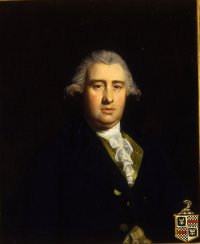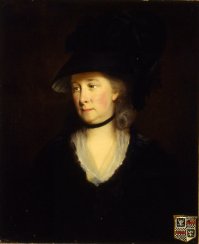Case Study 12: Sir Richard Hoare and Lady Frances Hoare by John Opie c.1780-85

Sir Richard Hoare by John Opie, c.1780-85
© Royal Albert Memorial Museum and Art Gallery and Exeter City Council
This study investigates the biographies of the sitters in a pair of portraits.
“This pair of portraits by John Opie of Sir Richard and Lady Hoare was bequeathed to RAMM in 1993 by
Pamela Mary Thompson. They were accepted as fine examples of the artist’s work and only the barest details of the sitters came with the bequest.
The portraits have, however, long been known in the literature on Opie. They were listed in Rogers’ 1878 catalogue of the artist’s work when they belonged to Mr Arthur Wyatt-Edgell (1). According to Rogers they had been painted for Wyatt-Edgell’s grandfather, Richard Wyatt, of Egham. Wyatt was one of Opie’s early London friends ‘instrumental in bringing
that artist out of his humble and modest lodging in Orange Court, Leicester Fields, to his home in Queen Street’ (2). (See also the portrait of Isabella Wyatt.) The friendship between Sir Richard Hoare and Wyatt was expressed in the former’s will by a bequest to him of land in St. Dunstan’s parish in the City as well as £50 for a mourning ring (3).
Sir Richard Hoare, first baronet (1735-1787), was the elder son of Sir Richard Hoare (1709-1754) by his first wife Sarah (nee Tully). Both father and son were principal partners in the highly successful banking business established in Fleet Street by an earlier Richard Hoare in 1672, the sitter’s great-grandfather (4). The bank was the principal source of the family’s fortune. Hoare’s Bank, now C. Hoare & Co., is the sole survivor of the private deposit banks established in the City of London in the seventeenth and eighteenth centuries (5). At his death Sir Richard left ‘each of the clerks employed in the banking business carried on in partnership at the house or shop in Fleet Street aforesaid twenty guineas for mourning.’
He also made specific bequests to the bank’s porter, Samuel Dawkins, and the under-porter, James Jordan (6).
Lady Frances Hoare by John Opie, c.1780-85.
© Royal Albert Memorial Museum and Art Gallery and Exeter City CouncilSir Richard was first married to his cousin, Anne Hoare (1737-1759), known as Nanny, daughter of Henry Hoare (1705-1785), banker, of Stourhead, and his wife, Susan Colt (d. 1743) (7). It was his father-in-law and uncle, Henry Hoare (1705-82) who developed the famous garden at Stourhead. Richard and Anne had two children – Henry Richard, who died young, and Richard Colt (1758-1838). She died six months after his birth. In May 1761 Richard married again, this time to Frances Ann Acland (1736-1800), daughter of Richard and Ann Acland of Beckenham in Kent (in turn related to the Devon Aclands), and with whom he had four sons and two daughters.
The children from both marriages grew up at the family home, Barn Elms Mansion at Barnes in Surrey, which was leased from the Dean & Chapter of St. Paul’s Cathedral. Alternatively known as the Manor House of Barnes, it was described as ‘a delightful and extensive villa on the Thames between Putney and Mortlake’ (8). Barn Elms had been built in 1694 on the site of the mansion owned by Sir Francis Walsingham, Secretary of State to Queen Elizabeth.
The 1694 house was remodelled by Sir Richard Hoare in 1771. Early nineteenth century prints show the river frontage of the main two storey house (9). It was of nine bays with a large hipped roof above the parapet. Either end of the main frontage were canted bay windows rising full height to a linking parapet. Each side there were lower wings. A possible interpretation is that in the 1771 remodelling the bays were added, together with the portico and side wings, thus transforming a classic late 17th century house with its steep pitched roof. On the entrance elevation the family crest of an eagle’s head surmounted the front door.
Between the First and Second World Wars the house became the home of the Ranelagh Polo Club. It was destroyed by fire in 1954, only an ice-house, a lodge and an avenue in Lower Richmond Road survive (10). In the Hoares’ time, as well as the park, there was farmland in Barnes and Putney maintained by a bailiff, as well as distant agricultural estates at Bulton and New Park in Somerset and Wiltshire.
Richard Colt-Hoare, the antiquary, in his Pedigrees and Memoirs of the family gives us a snapshot of his father (11):
‘It is truly gratifying to me, as his son, to speak in the highest terms of respect, gratitude, and affection of a most worthy father. He was of middling stature, dark complexion, and, in his latter years, inclined to en bon point [plumpness or stoutness]. He was more inclined to a retired and sedentary, than an active, life, particularly as to field sports. His care in educating a large family, and a constant attention to the improvement of his landed property, occupied his time both pleasantly and usefully. Deprived by fate of the companion of his early life, he contracted a second marriage with a most amiable woman, by which he left four sons and one daughter.’
A flavour of the richness of the lifestyle maintained by Sir Richard and Lady Hoare in their country house at Barnes and their townhouse on the west side of Lincoln’s Inn Fields is provided by the detailed bequests of his thirty-three page will (12). As well as the provision that she should continue to have the use of the pictures, drawings, prints, casts, books, china, furniture and other household contents at Barn Elms, Sir Richard makes specific bequests to her of ‘the French clock in her Dressing Room” and “the Rings, Bracelets, Watches and Pearles usually worn by her’ as well as ‘the Snuff Boxes, Miniature and Enamel Pictures and other Trinkets which shall be in her possession at the time of my decease.’ His own collection of ‘Watches Seals China Rings Gold Buttons Trinkets Medals Medallions and Swords’ should be disposed of by his widow as thought fit, while his ‘Silver Plate and other my diamonds and Jewells’ shall be divided equally between his two sons, Richard and Henry.
We hear of servants – Jane Lloyd working in the townhouse and also William Simons, servant at livery – but these must have been exceptional employees with a long service record as the Hoare family would have been supported by many pairs of hands. We can also imagine something of the music of the household because to his daughter Henrietta Ann Sir Richard leaves ‘her harpsichord and music books.’
On 27 June 1786 Richard Hoare Esq. of Barn Elms was created a Baronet, but he did not enjoy his new title for long, dying on 11th October 1787. The Royal Patent (13) acknowledged Sir Richard as ‘a man eminent for family inheritance, estate, and integrity of manners who generously and freely gave and furnished to us an aid and supply large enough to maintain and support thirty men in our foot companies, in our said Kingdom of Ireland to continue for three whole years, for the defence of our said kingdom, and especially for the security of the plantation of our said province of Ulster’. [Clear advantages to the Crown of the Hoare banking fortune. I am taking advice on just how normal this was or was it customary for those who could afford to buy these?] The King gave to the Hoares the right to bear ‘either in a canton (14) in their coat of arms, or in an escutcheon, at their pleasure, the arms of Ulster, (to- wit) an hand gules, or a bloody hand in a field argent.’
The arms of Hoare and Acland are as follows:
Hoare: Arms- Sa., an eagle displayed with two heads, arg., charged on the breast with an ermine spot, a bordure, engrailed, of the second. Crest- an eagle’s head, erased, arg., charged with an ermine spot. Motto- In ardua [meaning: On high] Seat- Stourhead House, Bath.
Acland: Arms- Chequy, ar. and sa., a fesse gules, quartering Wrothe and Dyke. Crest- a man’s hand, couped at the wrist, in a glove, lying fessways, thereon a falcon, perched, all ppr. Motto- Inebranlable [meaning: Not to be shaken]. Seats- Killerton, Exeter; and Holnicote, Taunton, co. Somerset (15).
Sir Richard died at Bath in 1787, and was succeeded by his son Sir Richard-Colt Hoare FRS, FSA, FLS, the antiquary, (1758-1838). A monument to Sir Richard, by J.Hickey, was erected in St. Mary’s Church, Barnes. It depicts a mourning woman and child by an urn. It was however badly damaged in the 1978 fire that gutted the church (16). Dame Frances Hoare died on 10th September 1800 at the age of 63. by which time she had moved to Beckenham.
She was buried with her husband at Barnes, but at St. George’s, Beckenham there is a Grecian tablet monument by Flaxman commemorating her surviving family of four sons and one daughter (17).
Other likenesses
In 1819 Colt Hoare recorded half-length portraits at Stourhead of his father by Coates, in crayons and copied in oils by Woodforde and of his step-mother, by Angelica Kauffman (18).
A half-length portrait of Sir Richard, without details of the artist, is illustrated in the 1932 company history.”
Author: Stephen Price
Footnotes
- John Jope Rogers Opie and his Works: being a Catalogue of 760 Pictures by John Opie, R.A. preceded by A Biographical Sketch (Colnaghi & Co., London & Netherton & Worth, Truro, 1878)
- Ibid. citing J.T.Smith Book for a Rainy Day (1861)
- The National Archives (TNA) PROB11/1158 Will of Sir Richard Hoare of Barnes, Surrey 30th October 1787.
- C.Hoare & Co. Hoare’s Bank: a record 1673-1932 (London, private circulation, 1932)
- http://www.hoaresbank.co.uk/html/history
- TNA PROB11/1158
- Victoria Hutchings, ‘Hoare, Sir (Richard) Colt, second baronet (1758-1838)’, Oxford Dictionary of National Biography, Oxford University Press, 2004
- E.Woodbridge Landscape and Antiquity, Aspects of English Culture at Stourhead, 1718-1838 (Oxford, 1970) p. 71.
- Early 19th century engraved view of the river elevation of Barn Elms inscribed: “Barn Elms Surrey The Seat of the Right Hon. Sir Lancelot Shadwell, Knt., Vice Chancellor of England by whom this Plate was Presented. T. Allom. Engraved for Brayley’s History of Surrey. H. Griffiths, Dorking. Published by & for R.B. Ede.” Print available online at www.londonancestor.com/surrey/barn-elms.htm
- Bridget Cherry & Nikolaus Pevsner The Buildings of England: London : South (Penguin Books, London, 2001) p.470.
- Sir Richard Colt Hoare, Bart. Pedigrees and Memoirs of the Families of Hore, of Rishford, Com. Devon; Hoare, of Walton, Com. Bucks; Hoare , of London, Com. Middlesex; Hoare, of Mitcham, Com. Surrey; Hoare, of Stourton, Com. Wilts; Hoare, of Barn-Elms, Com. Surrey; Hoare, of Boreham, Com. Essex (Bath, 1819) p.32.
- TNA PROB11/1158
- Quoted by Colt Hoare op.cit. p. 58.
- If an object is described as being IN CANTON, it occurs in the top right of the arms, as seen from the reverse. Heraldically, a Quarter covers one fourth of the field whereas a Canton covers one ninth of the field.
- Sir Bernard Burke A Genealogical and Heraldic Dictionary of the Peerage & Baronetage 1892 (Acland p.15; Hoare pp.711-2).
- Cherry & Pevsner op.cit. p.468.
- John Newman The Buildings of England: West Kent and the Weald (Penguin Books, 1969) pp.141-2
- Colt Hoare op.cit. p.50.

